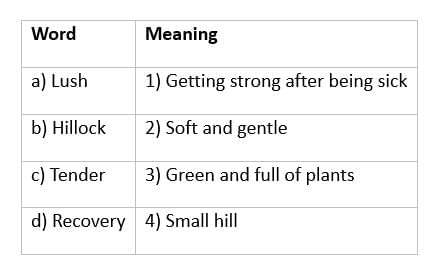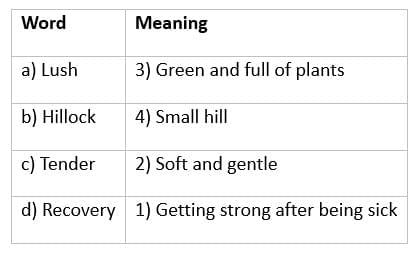Class 4 Exam > Class 4 Notes > English for Class 4 (Santoor: New NCERT) > Unit Test (Solutions): The Old Stag
Unit Test (Solutions): The Old Stag | English for Class 4 (Santoor: New NCERT) PDF Download
M.M: 20
Attempt all questions.
- Question numbers 1 to 4 carry 1 mark each.
- Question numbers 5 to 7 carry 2 marks each.
- Question numbers 8 to 9 carry 3 marks each.
- Question numbers 10 carry 4 marks each.
Q1. Where does the stag rest? (1 mark)
a) Big mountain
b) Small hill
c) Dry desert
d) City park
Ans: Small hill.
The stag rests on a small hill.
Q2. What does the stag eat to get strong? (1 mark)
a) Hard rocks
b) Soft grass
c) Tree bark
d) Sand
Ans: Soft grass.
Soft grass helps the stag get strong.
Q3. What did animals do wrong at first? (1 mark)
a) Shared grass
b) Took too much
c) Planted trees
d) Cleaned forest
Ans: Took too much.
Animals took too much of stag’s grass.
Q4. What should we do with nature’s gifts? (1 mark)
a) Use them carefully
b) Take them all
c) Hide them
d) Throw them away
Ans: Use them carefully.
We should use nature’s gifts carefully.
Q5. Why did animals eat the stag’s grass? (2 marks)
Ans: Animals ate the stag’s grass because it was soft and yummy. They wanted it for themselves and didn’t think about the stag. Taking too much left the stag with no food to get strong, which made him weak.
Q6. How can we save nature’s gifts? (2 marks)
Ans: We can save nature’s gifts by taking only what we need. Share things like water, food, or plants with others. Don’t take too much, so everyone has enough. This keeps nature safe and happy.
Q7. Why is taking too much bad? (2 marks)
Ans: Taking too much is bad because it leaves less for others. If we take all the food or water, others cannot use it, which can harm people, animals, and nature. Sharing ensures fairness and makes everyone happy.
Q8. How did animals fix their mistake? (3 marks)
Ans: The animals fixed their mistake by stopping eating the stag’s grass. They went to find food somewhere else so the stag could have enough to eat. Some animals brought fresh leaves for him. When it rained, the grass grew back. This helped the stag get strong again. The animals learned to care for their friend and not take too much. They worked together to make sure the stag had what he needed to be healthy and happy.
Q9. Why must we share nature’s gifts fairly? (3 marks)
Ans: We must share nature’s gifts fairly so everyone gets enough. Taking too much, like all the water or plants, hurts others who need them, like animals or friends. Sharing keeps nature healthy and strong for all. It’s like making sure everyone gets a piece of cake at a party. If we share, no one goes hungry, and we all stay happy. Nature gives us lots, but we need to use it carefully so it lasts. This shows we care for each other and our world.
Q10. Match the words with their meanings. (4 marks)
Ans:
The document Unit Test (Solutions): The Old Stag | English for Class 4 (Santoor: New NCERT) is a part of the Class 4 Course English for Class 4 (Santoor: New NCERT).
All you need of Class 4 at this link: Class 4
|
41 videos|476 docs|39 tests
|
FAQs on Unit Test (Solutions): The Old Stag - English for Class 4 (Santoor: New NCERT)
| 1. What is the main theme of "The Old Stag"? |  |
Ans."The Old Stag" primarily explores themes of wisdom, the cycle of life, and the coexistence of nature and humanity. It uses the character of an old stag to symbolize experience and the inevitable passage of time, reflecting on how different generations perceive life and its challenges.
| 2. Who are the key characters in "The Old Stag"? |  |
Ans.The key characters in "The Old Stag" include the old stag himself, who represents wisdom and the natural order, and various younger animals that embody different perspectives on life and survival. Their interactions highlight the contrasts between youth and age, and the lessons learned through experience.
| 3. What moral lessons can be derived from "The Old Stag"? |  |
Ans."The Old Stag" imparts several moral lessons, such as the value of wisdom gained through experience, the importance of respecting nature, and the idea that every creature has its role in the ecosystem. It encourages readers to reflect on their own lives and the knowledge passed down through generations.
| 4. How does the setting influence the story in "The Old Stag"? |  |
Ans.The setting of "The Old Stag" plays a crucial role in shaping the narrative. The natural landscape serves as a backdrop for the interactions among the characters, emphasizing the beauty and harshness of the wild. It also underscores the themes of survival and adaptation, illustrating how the environment influences the behaviors and decisions of the animals.
| 5. What literary techniques are used in "The Old Stag"? |  |
Ans."The Old Stag" employs various literary techniques, including personification, vivid imagery, and symbolism. The animals are given human-like qualities, which allows readers to connect with their struggles and triumphs. The use of rich descriptions creates a vibrant setting, while symbolism, particularly through the stag, enhances the thematic depth of the story.
Related Searches
















